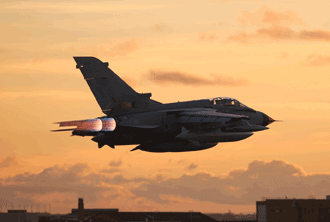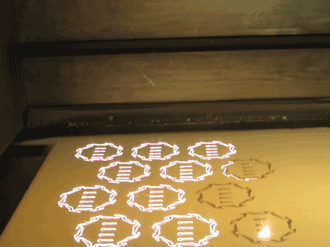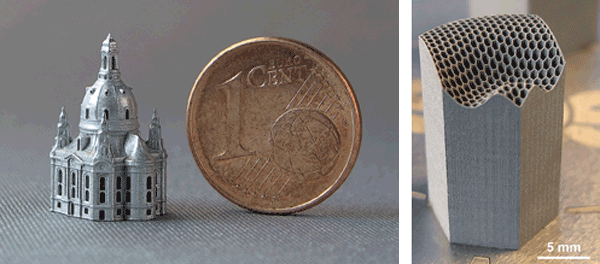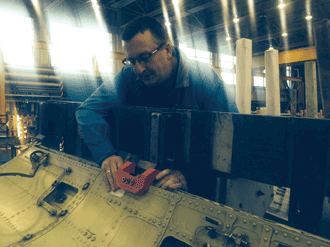Advances in laser sintering 3-D printing speed up production of parts with complex geometries, all while cutting costs. If it can overcome challenges including a lack of standards, training and design tools, it could be unstoppable.
From fabricating airplane parts to building houses and even creating custom cookies, 3-D printing and associated techniques are taking off, in part because of advances in the technology, including improvements in laser sintering methods. These innovations enable faster yet less expensive fabrication of complex geometries, including some not possible via conventional subtractive manufacturing methods. But 3-D printing faces hurdles: a lack of design tools, expertise and standards.

An RAF Tornado plane flies with the first 3-D-printed metal parts. Photo courtesy of BAE Systems.
Even so, when it comes to laser-based 3-D manufacturing, the sky’s literally the limit. In late 2013, BAE Systems, the London-based defense and aerospace company, announced the successful flight testing of a 3-D-printed stainless steel bracket on a Tornado fighter jet.
“Recent advances in materials and machine capability have enabled the production of parts with sufficient quality that they can be qualified and used on our products,” said Matthew Stevens, team leader for additive manufacture development in BAE’s military aircraft and information businesses.
The company is now developing 3-D printing for large structures, he added. The metal printing technology and an extrusion process suitable for plastics give BAE Systems a complete 3-D capability.

This 3-D-printed titanium spar section is 1.3 m long and was produced in a mere 37 hours (from digital model to complete part) as part of a collaboration between BAE Systems and Cranfield University to develop processes for the manufacture of large structural parts using additive manufacturing. Photo courtesy of BAE Systems.
The company has stated that one reason to put this new technology to use is lower cost, with 3-D printing potentially saving it £1.2 million ($2.02 million) by 2017 through just one part alone. 3-D printing also would allow BAE to make parts on aircraft carriers – and possibly on front lines – thereby enabling product support not possible with traditional manufacturing methods.
Military and defense contractors can solve some significant parts supply problems by using 3-D printing. For one thing, defense programs have multiyear production runs. Some fighter jets will fly for decades, with the F15 that was introduced in the 1970s now slated to still be in the air until the 2030s. Being able to custom make suitable replacement parts could go a long way toward solving what could otherwise be a thorny supply problem. Thanks to inventory reductions, a capability to manufacture on the spot could also save money.
“You’ve also got the actual cost in the supply chain of holding spare parts. When parts are critical and you want to go into operation, you’re going to want to store those parts, just in case,” said Brendan Viggers, head of product management at IFS Aerospace & Defense, a division of the global enterprise applications company IFS of Linköping, Sweden.
In addition to BAE, GE Aviation and Rolls Royce are also beginning to use 3-D printing technology. GE has announced that such techniques have allowed it to consolidate 20 different pieces within one fuel nozzle into just one part for its next-generation jet engines, due to begin production in 2015. 3-D printing technology also enabled a weight savings of 25 percent.
Bigger, smaller
As for vendors of 3-D laser-based printing systems, they’re looking to go both bigger and smaller. An example of the former can be seen in recent laser sintering offerings from Germany-based EOS, which has its U.S. headquarters in Novi, Mich. The company’s new EOS M 400 has a build volume of 400 mm on a side, meaning it can fabricate parts that fit within a cube almost half a meter on a side, according to Andy Snow, senior vice president of EOS North America. That’s big enough for most industrial applications, 80 percent of which fall within a 250-mm3 volume requirement, according to Snow.

A direct metal laser sintering system enables the printing of complex 3-D geometries. Photo courtesy of Harbec Inc. and EOS North America.
Over the years, EOS has focused on reducing the overall cost to additively produce a part. In laser sintering, a coating of powder is spread over a build platform, and a laser beam fuses the powder into a thin layer. The process repeats over and over until the part is completed.
One way to cut costs is to use a more powerful laser. That increases scan speeds – but that’s only generally true. “We try to go to higher powers for faster scan speeds, but not every material likes to operate at higher powers,” Snow said.
Stainless steel 3-D printing, for example, works best in terms of speed and quality if laser power is 200 W. Aluminum, on the other hand, prints best when a full kilowatt is used. The latest EOS products have a kilowatt laser, and the power can be tuned according to the material being fabricated. Unlike metals, polymer 3-D printing is sensitive to wavelength, the speed of heating and cooling of the material, and many other variables.

Very small, intricate shapes can be 3-D printed by using powder composed of finer than usual particles and a smaller laser focal size than normal. Photo courtesy of 3-D MicroPrint.
Other techniques that can speed up 3-D printing are bidirectional powder recoating and the use of more powerful computers; the latter are needed because the system calculates how to scan the laser, with this taking place between exposures of successive layers.
A divide-and-conquer strategy is one way to further increase speeds: Multiple lasers could each work on separate segments of a part. The increase in speed will be somewhat less than the total number of lasers, due to the need to overlap the scan patterns. EOS has announced plans to introduce a four-laser upgrade of its latest product.
Another way to increase part production rates is to integrate 3-D printing into production cells, with such features as automated powder removal. Those types of developments will be needed for ongoing cost reduction, Snow said.
When it comes to going small in 3-D printing, an example can be seen in 3-D MicroPrint of Chemnitz, Germany. The newly formed company is a joint venture of EOS and laser-micromachining provider 3-D-Micromac AG. 3-D MicroPrint will produce systems capable of making parts too small for other 3-D printers.
The company will sell systems as well as part fabrication services, said Matthias Winderlich, 3-D MicroPrint business development manager. Other 3-D printing systems use powder coatings comprising particles in the 30- to 100-µm range. In contrast, 3-D MicroPrint will use powders composed of particles that are less than 5 µm in size.
In addition to smaller particles, the systems will use more finely focused laser beams, concentrated into spots that measure about 30 µm in diameter. That compares to the roughly 100-µm spot size of other systems.
“With these small focus points, we can build up walls, for example, smaller than 70 µm in thickness,” Winderlich said.
The surface will be smooth, with a roughness of 2 µm, he added. That’s a feat difficult for other systems, in part because the powder particle size and focal diameter are too large.
The tradeoff is that this ability to print finer features comes with a requirement that more passes are needed to build up the same part volume. Therefore, this approach is not really suitable for fabricating big parts. Partly for that reason, 3-D MicroPrint is finding the strongest interest in the medical device arena as well as watchmaking, optical components, MEMS devices and other sensors.
Just because the parts are small doesn’t mean they can’t have a big impact. In particular, small yet highly precise structures can play an outsize role in large products. The performance of a jet engine, for example, may depend upon the microscopic clearance within a nozzle or the exact shape of a turbine blade. Either of the latter could have very tight tolerances, making fine fabrication important.
Beyond prototyping
Thanks to these and other advances, 3-D printing is moving from prototyping into other uses, according to Rob Gorham, the deputy director of technology development at America Makes, a consortium targeting 3-D printing and additive manufacturing.
Originally developed for prototyping, 3-D printing and additive manufacturing are now being used for functional prototyping, which is the fabrication of prototypes that go into planes that fly or cars that move. The next steps will be to use 3-D printing to extend the life or increase the flexibility of tooling, as well as possibly to repair parts. Eventually, the technology will fabricate end-use parts, such as the mass-produced units found at retail stores.

This 3-D-printed part is being installed into a plane at RAF Marham in England. Photo courtesy of BAE Systems.
Getting there will require the development of standards so that 3-D printing info can be exchanged. There also is a need for models that simulate what happens when laser power, wavelength or pulse width are changed. Another need is for a method to monitor printing as it happens, so that any needed corrective steps can be taken immediately. Because different materials require differing process parameters, there’s also a need for systems with a wide array of 3-D printing technologies.
America Makes is working on and funding research in these and other areas, and progress is being made, Gorham said. But the cost of 3-D printing has dropped significantly, lowering the greatest barrier to use of the technology, he added.
What’s more, the price for laser sintering may plunge further, if past history holds. 3-D printing using fused filament fabrication, an extrusion process, is now in inexpensive desktop systems, in part because patents expired. The same sequence may happen with 3-D laser printing, which has a number of patents due to expire over the next few years.
“I’m confident we’re going to see the same opportunity for laser sintering,” Gorham said.